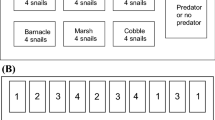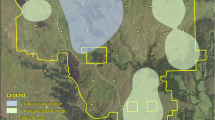Abstract
Complex environments present substantial spatio-temporal uncertainty in where and when rare ecological resources become available. How animals navigate this uncertainty to turn the seemingly unpredictable into the predictable is a fundamental question in evolutionary ecology. Here we use subtidal hermit crabs (Pagurus acadianus) as a model system to experimentally test in the field how animals resolve spatio-temporal uncertainty in resource availability. Quadrat sampling within the subtidal zone revealed that hermit crabs face an extreme ecological challenge, based on the rarity of empty shells across space and time. We show how this spatio-temporal uncertainty is ultimately resolved using long-distance chemical cues, which are associated with non-destructive shell predation on living gastropods, the original source of shells. By experimentally releasing cues that simulated the chemical by-products of predation, we reveal that certain flesh cues provide fine-grained information about the precise spatial and temporal window of new shell availability. These cues were most attractive to individuals with the greatest existing resource needs, and in the absence of this information individuals were highly constrained in their ability to discover newly available resources. Broadly, these experiments reveal that exploiting simple cues from heterospecific predators can provide a solution to the general ecological challenge of finding resources that are rare in space and time.





Similar content being viewed by others
References
Alcaraz G, Arce E (2017) Predator discrimination in the hermit crab Calcinus californiensis: tight for shell breakers, loose for shell peelers. Oikos 126:1299–1307
Asahina K, Pavlenkovich V, Vosshall LB (2008) The survival advantage of olfaction in a competitive environment. Curr Biol 18:1153–1155
Bates KM, Laidre ME (2018) When to socialize: perception of time-sensitive social structures among social hermit crabs. Anim Behav 138:19–27
Bertness MD (1981) Conflicting advantages in resource utilization: the hermit crab housing dilemma. Am Nat 118:432–437
Breithaupt T, Thiel M (2011) Chemical communication in crustaceans. Springer, New York
Carriker MR (1981) Shell penetration and feeding by naticacean and muricacean predatory gastropods: a synthesis. Malacologia 20:403–422
Cronin TW, Johnsen S, Marshall NJ, Warrant EJ (2014) Visual ecology. Princeton University Press, Princeton, NJ
Dall SRX, Giraldeau LA, Olsson O, McNamara JM, Stephens DW (2005) Information and its use by animals in evolutionary ecology. Trends Ecol Evol 20:187–193
Gherardi F, Tricarico E (2011) Chemical ecology and social behaviour of Anomura. In: Breithaupt T, Thiel M (eds) Chemical communication in crustaceans. Springer, New York, pp 297–312
Grant WC (1963) Notes on the ecology and behavior of the hermit crab, Pagurus acadianus. Ecology 44:767–771
Greggor AL, Laidre ME (2016) Food fights: aggregations of marine hermit crabs (Pagurus samuelis) compete equally for food- and shell-related carrion. Bull Mar Sci 92:293–303
Hanley ME, Collins SA, Swann C (2011) Advertising acceptability: is mollusk olfaction important in seedling selection? Plant Ecol 212:727–731
Harzsch S, Krieger J (2018) Crustacean olfactory systems: a comparative review and a crustacean perspective on olfaction in insects. Prog Neurobiol 161:23–60
Hazlett B (1981) The behavioral ecology of hermit crabs. Annu Rev Ecol Syst 12:1–22
Hussey NE, Kessel ST, Aarestrup K et al (2015) Aquatic animal telemetry: a panoramic window into the underwater world. Science 348:1255642
Laidre ME (2007) Vulnerability and reliable signaling in conflicts between hermit crabs. Behav Ecol 18:736–741
Laidre ME (2010) How rugged individualists enable one another to find food and shelter: field experiments with tropical hermit crabs. Proc R Soc B Biol Sci 277:1361–1369
Laidre ME (2011) Ecological relations between hermit crabs and their shell-supplying gastropods: constrained consumers. J Exp Mar Biol Ecol 397:65–70
Laidre ME (2012a) Niche construction drives social dependence in hermit crabs. Curr Biol 22:R861–R863
Laidre ME (2012b) Homes for hermits: temporal, spatial and structural dynamics as transportable homes are incorporated into a population. J Zool 288:33–40
Laidre ME (2013) Eavesdropping foragers use level of collective commotion as public information to target high quality patches. Oikos 122:1505–1511
Laidre ME (2014) The social lives of hermits. Nat Hist 122:24–29
Laidre ME, Elwood RW (2008) Motivation matters: cheliped extension displays in the hermit crab, Pagurus bernhardus, are honest signals of hunger. Anim Behav 75:2041–2047
Laidre ME, Greggor AL (2015) Swarms of swift scavengers: ecological role of marine intertidal hermit crabs in California. Mar Biol 162:969–977
Laidre ME, Trinh R (2014) Unlike terrestrial hermit crabs, marine hermit crabs do not prefer shells previously used by conspecifics. Crustaceana 87:856–865
Laidre ME, Vermeij GJ (2012) A biodiverse housing market in hermit crabs: proposal for a new biodiversity index. Cuadernos de Investigación UNED 4:175–179
Laidre ME, Patten E, Pruitt L (2012) Costs of a more spacious home after remodeling by hermit crabs. J R Soc Interface 9:3574–3577
Lawson DA, Whitney HM, Rands SA (2017) Nectar discovery speeds and multimodal displays: assessing nectar search times in bees with radiating and non-radiating guides. Evol Ecol 31:899–912
Levin SA (1992) The problem of pattern and scale in ecology. Ecology 73:1943–1967
McLean RB (1974) Direct shell acquisition by hermit crabs from gastropods. Experientia 30:206–208
Moody KE, Steneck RS (1993) Mechanisms of predation among large decapod crustaceans of the Gulf of Maine Coast: functional vs. phylogenetic patterns. J Exp Mar Biol Ecol 168:111–124
Mukhin VA, Smirnova EB, Novikov VY (2007) Peculiarities of digestive function of proteinases in invertebrates-inhabitants of cold seas. J Evol Biochem Physiol 43:476–482
Noë R, Hammerstein P (1994) Biological markets: supply and demand determine the effect of partner choice in cooperation, mutualism and mating. Behav Ecol Sociobiol 35:1–11
Rittschof D (1980) Chemical attraction of hermit crabs and other attendants to simulated gastropod predation sites. J Chem Ecol 6:103–118
Rittschof D, Cohen JH (2004) Crustacean peptide and peptide-like pheromones and kairomones. Peptides 25:1503–1516
Roberts L, Elliott M (2017) Good or bad vibrations? Impacts of anthropogenic vibration on the marine epibenthos. Sci Total Environ 595:255–268
Stevens M (2013) Sensory ecology, behaviour, and evolution. Oxford University Press, New York
Stutz RS, Croak BM, Proschogo N, Banks PB, McArthur C (2017) Olfactory and visual plant cues as drivers of selective herbivory. Oikos 126:259–268
Tran MV (2015) Behavioral reactions to novel food odors by intertidal hermit crabs. Behav Proc 113:35–40
Vermeij GJ (1993) A natural history of shells. Princeton University Press, Princeton, NJ
Vermeij GJ (2010) Sound reasons for silence: why do molluscs not communicate acoustically? Biol J Lin Soc 100:485–493
Weissburg M, Roseman L, Chase ID (1991) Chains of opportunity: a Markov model for acquisition of reusable resources. Evol Ecol 5:105–117
Wilber TP, Herrnkind WF (1984) Predaceous gastropods regulate new-shell supply to salt marsh hermit crabs. Mar Biol 79:145–150
Acknowledgements
This research was approved by Shoals Marine Laboratory. For valuable field support we thank SML staff, especially Jim Coyer, Mike Rosen, Amber Litterer, Katy Bland, Bonny Clarke, and SML director Jennifer Seavey. We are grateful to all members of the Laidre lab for helpful feedback on the manuscript during a fall 2017 presentation. This research was supported by Dartmouth College startup funds to ML, a UGAR grant to LV and ML, and support from SML. We are especially grateful to Bill Kneisel for his generous gift supporting this line of research. The authors declare no conflicts of interest.
Author information
Authors and Affiliations
Corresponding author
Electronic supplementary material
Below is the link to the electronic supplementary material.
Crab’s eye view of the poor visibility in the subtidal as seaweed washes back and forth in waves, obscuring the view. Footage is of a hermit crab (Pagurus acadianus) in the subtidal of the Isle of Shoals (MOV 22165 kb)
Rights and permissions
About this article
Cite this article
Valdes, L., Laidre, M.E. Resolving spatio-temporal uncertainty in rare resource acquisition: smell the shell. Evol Ecol 32, 247–263 (2018). https://doi.org/10.1007/s10682-018-9937-4
Received:
Accepted:
Published:
Issue Date:
DOI: https://doi.org/10.1007/s10682-018-9937-4




